Racial Profiling: Delineating the Renaissance Face
Noam Andrews
[print edition page number: 347]
What does the face of another tell us? What inferences can be made about character, emotional state, intelligence, morality, and social status? And by what means may the individual be aggregated into similar types and prepared for visual reproduction and analysis, in turn used to make broader assumptions about the behavior of similar looking people? At the digital dawn of facial tuning and face recognition software, and in policing practices spanning airport security to the dangers of “driving while black” (and other everyday activities), questions such as these have penetrated the cultural consciousness as never before, drawing attention to the insidious effects of racial profiling as well as the collusion of societal structures in perpetuating bias. But the operative use of external human features to determine inner character or qualities has a deep history stretching back through the Enlightenment and post-Enlightenment sciences to pseudo-Aristotle, Theophrastus, and beyond, from philosophy and anatomical study to parody and propaganda.[1] Termed “physiognomy” and expanded into anthropometry, craniometry, and phrenology (the measurement of the shape of the skull to establish mental traits) in the [348] nineteenth century, these clusters of practices were responsible for generating an untold number of treatises and tractates.[2]
Though his scientific work has not often been analyzed within this framework, Albrecht Dürer (1471–1528), Germany’s most famous artist, published just before he died a highly influential if eccentric treatise called Vier Bücher von menschlicher Proportion [Four Books on Human Proportion] (1528) (hereafter menschlicher Proportion) which contributed to developing and reinforcing these practices. While it refrained, importantly, from designating or labeling what we would describe today as nationality or ethnicity, or any descriptive aspects of character, it nevertheless proved important to the establishment of what would later become the prevailing parameters for a self-consciously “objective” representation of the human face in profile (figure 1). Much like other contemporary Renaissance treatises that sought to analyze and categorize the human body, Dürer stressed that geometry was fundamental to defining well-ordered and proportional rules of appearance.[3] But in moving beyond the pursuit and visualization of a singular and stable ideal proportion (for “no single man can be taken as a model for a perfect figure”) or moralistic critiques of “licentious” proportions, menschlicher Proportion was unique in its evocative framework for mapping transformational relationships between body types and faces, and thus gave credence to the idea that mathematics could reveal the hidden rules underlying all bodies.[4] [349]
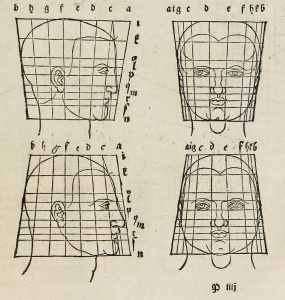
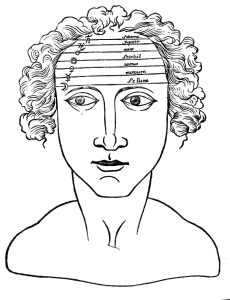
Dürer’s incursion into the physiognomy of the human profile was anything but unprecedented. Amongst topical forays into the mathematics of ideal proportion and animal physiognomy, the Renaissance face was theorized through a disparate array of diagnostic graphemes whose primary and overlapping purpose was to discern the most profound nature of self (figure 2 and figure 3).[5] The journals and private papers of the Renaissance [351] artists Leonardo da Vinci and Peter Paul Rubens, among many Old Masters, reveal myriad experimental and evolving approaches to the theorization and construction of the face, traversing the Vitruvian man to the grotesque — the opposing and equally idealized poles of human perfection and deformity.[6]
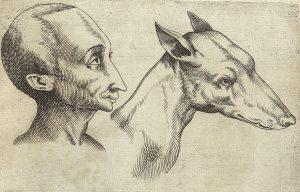
In this context, it is important to include Dürer when we teach the history of the concept of race in Europe, because of the direction history would go, particularly in Germany with the rise of fascism, and moreover Dürer’s enduring symbolism, embraced from Vasari to Hitler, as the German artist par excellence. Dürer’s contribution to physiognomy is acutely significant, even though menschlicher Proportion would only become reinterpreted in racial terms long after his death (figure 4).[7] Though Dürer could not have known the ways in which his work would be used, a pertinent question remains to be debated. Were his theoretical diagrams on the proportions and transformation of the human body already seeded from their inception with bias? And if so, does this not mean that his treatises on measurement should be studied in relation to the long and violent history of race in Europe and beyond. [352]
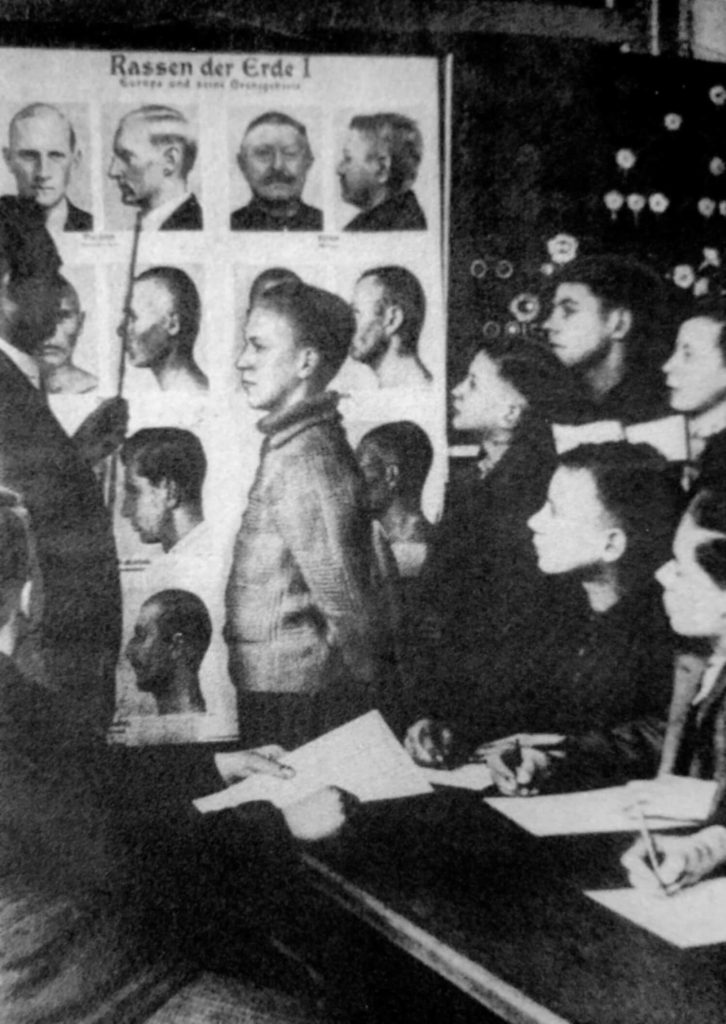
In teaching race in the Renaissance, then, it is crucial to study the way visual strategies were used to parcel up humanity into distinct groups of operationally interchangeable individuals. Dürer is due the unwelcome credit of having proffered decisive steps toward the establishment of the human profile as both site and tool for the fixing of identity, thus instantiating a visual language that would become increasingly central to what would ultimately devolve into modern racist typologies based upon physical appearance. Among the most celebrated of the initial forays into the [353] development of systems to classify human variety based upon experimentation, testing, and the scientific method, Enlightenment physiognomy would prove to be widely read and disseminated, influencing the science of Johann Wolfgng von Goethe and the evolutionary theories of Charles Darwin, and in the process directly contributing to a fraught if modern concept of race as well as its fascistoid manifestations.[8] Dürer and his Enlightenment afterlife deserve reassessment though we must balance our expectations of these historical actors’ motivations with our knowledge of the entrenched systems of exploitation that their work may have inadvertently, or calculatedly, tapped into, triggered, or offered itself up to. Querying what we see when we see, and, moreover, who the we is that sees (or is being seen), is a perceptual terrain neither originating nor terminating with Dürer, though Dürer’s measured approaches to the representation of the face would have a profound impact upon the visualization of racial difference in the centuries to come.
• • •
Media imbedded with “techno-racism” is an old problem whose institutional roots in the western world far predate the contemporary realization that modern technology, no matter how allegedly objective or utopian in aim, is no better than its programmers, and thus inexorably performs the uninterrogated biases of its creators or majority users.[9] Classical physiognomy and its visual elaborations are no exception. Both extensively plotted the overall contours of a value system celebrating ethnic stereotypes on the basis of skin color, gender, corporeal attributes, and the effects of the environment. Although the determinative judgements [354] made varied between texts and could substantially contradict each other, the fundamental anthropological battle lines of modernity presented itself in full visibility: light vs. dark, north vs. south, and here vs. there (the there standing in for any number of distant locales).[10] Further shaping the discourse on physiognomy through the dominant Christian paradigm, medieval scholars expanded upon the Bible, splicing humanity into tribes or races descended from the three sons of Noah — Shem, Ham, and Japheth — each of whom were responsible for populating Asia, Africa, and Europe, respectively.[11] Evocatively illustrated in books of wonders or breathlessly regaled in popular travel literature such as The Travels of John Mandeville (mid/late fourteenth century), medieval authors sutured together relative geographic distance from Europe with a moral turpitude reflected in the appearances, behaviors, and customs populating the margins of the European imagination. In this context, non-Western catchall quasi-ethnicities such as “Ethiopians” were designated “the remotest and foulest of mankind” as per Augustine of Hippo, at once human and humanoid, their blackness incorporated into a fertile slew of monstrous attributes.[12]
Against this backdrop, menschlicher Proportion, which was published in the same year as Dürer’s death in 1528 and forms the intellectual pinnacle of his numerous contributions to the theorizing of the human body, appears incongruous — which to a large extent it is.[13] Conceptualized as a more advanced text on applied mathematics to be studied after his treatise on Euclidean geometry, Underweysung der Messung [Treatise on [355] Measurement] (1525), menschlicher Proportion is devoted primarily to exploring the corporeal ratios and measurements of different bodies and is wholly bereft of the lurid exposition later characteristic of physiognomy and its offshoots. By contrast, contemporary notes by Dürer contained at the British Museum acknowledge what he felt to be the book’s greatest challenge: namely, not the circumscribing of human difference through narrative illustration, but the representation of the many irregularities of the body and the structured dimensions of component body parts. As he observes, “The ‘measure’ of a human figure is especially hard to comprehend, amongst other reasons because the human figure is composed neither by rule nor compass but is contained within irregular curved outlines, it is specially hard to write and treat of it.”[14]
Dürer’s sketches evidence many attempts at working through competing graphical techniques, though he would eventually move toward effecting systems of mathematical proportions that more closely reflected those contained within the printed edition of menschlicher Proportion. Like Leon Battista Alberti and Leonardo da Vinci before him, both of whom surveyed classical statues, living models, and even architecture to compile statistical data on the well-proportioned body, Dürer accumulated his own measured surveys of bodies, though at a much larger and more comprehensive scale than the Italians.[15] In pursuit of a balance between ideal proportionality and the mean values he had determined through direct measurement of human subjects, menschlicher Proportion elides a penultimate proportional ratio. The treatise accordingly contains a spectrum of adult physiques, as well as measurements of toddlers, and defines a range of idealized human specimens divided into several types [356] (thinner, stouter, shorter, taller, more or less muscular) reflective of the physical variation of humanity.[16]
The inclusion of multiple competing proportional systems and physiques lends menschlicher Proportion an uncanny fluidity, since Dürer was as expressly interested in how bodies might be transformed into one other as he was in fixing the measurement of specific bodies in stasis. In particular, his striking demonstrations in Book III (fol. P3v – fol. Q6r) of the geometrical rules underlying the metamorphosis of the human face, the diagrams which would so capture the imagination of the Swiss physiognomist Johann Kaspar Lavater (1741–1801), the Dutch physician Petrus Camper (1722–1789), and later the Scottish biologist D’Arcy Wentworth Thompson (1860–1948), represents one of, if not the first, sustained, geometrical dissections of the (male) profile in Western art and science. As we saw in Figure 1, Dürer maps an ideal human head upon a three-dimensional grid (cubus) in order to explain how varying this grid will result in reciprocal changes to the form of the head, “and how thus various forms of the face can be made.”[17] He begins by compressing the x- and y-axes, which in turn generates thinner or squatter heads, and then moves to skewing the outer edges of the grid at an angle so that “the first head has a tapered forehead, but the other has a flared head” and inflating or deflating the head to fit within convex (außgebogen) or concave (eyngebogen) curves (figure 5).[18] These archetypal changes to the structure of the human head, for Dürer, gesture toward the infinite variations of nature.[19] Accordingly, to learn his graphical techniques and furthermore to combine them, was to attain the ability to reproduce nature’s ever-shifting [357] essence, of more use “to describe difference than the shape of beauty.”[20] In this one short passage, Dürer had hinted at a new avenue of exploration for the studying of types of faces that were not generally exposed to mathematical scrutiny.
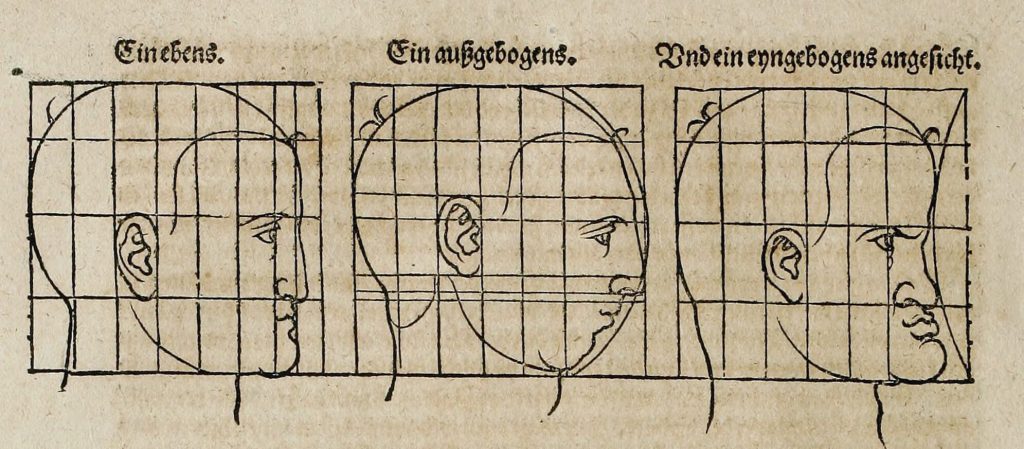
Dürer admits that a convincing restructuring of the human head on paper requires a significant amount of essential detail to be filled in by the artist. It was not enough solely to translate or alter the head according to locating lines (ort lini), prefigurings of what Camper would designate as the linea facialis [facial line]. The morphology of facial features could be further mapped by framing the face within control points (figure 6), denoted here with the letters to the right of each profile and which stretched and condensed the nose, chin, eyes, and mouth when slid up and down, though he does not go into the specifics of how to render this detail. The framing text simply enumerates the shifting of the determining construction lines, leaving any impression one might have about the nature of [358] these subjects unsaid. By not being proscriptive, menschlicher Proportion goads the viewer into making further assumptions — about beauty, but also intelligence, social standing, age, and emotional state. These faces, simply through having been positioned in comparative profile, seem to divulge their unique interiorities, interiorities predicated upon the deformation of proportional relationships and the capacity of the artist to convincingly render their exteriority in shorthand.
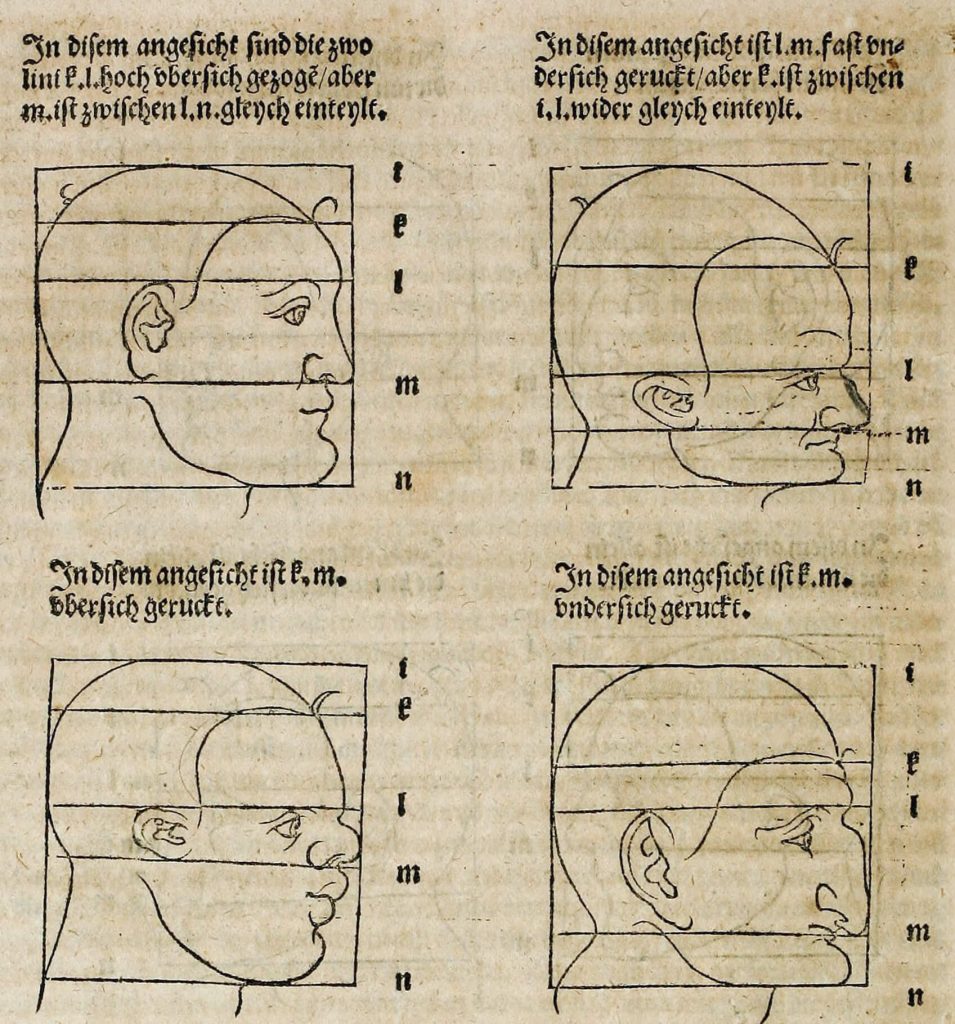
Dürer’s broader oeuvre testifies to an ambivalent relationship to the representation of racial difference. Physiognomy lingers at the conceptual edges of his profile studies, most of which, in their exaggeratedness, verge [359] into the realm of caricature and test a viewer’s desire not to read character traits into them. On the other hand, menschlicher Proportion, which otherwise eschews stereotypical, ethnic indicators in favor of constructing general, vaguely Eurocentric facial features, does include one singular head that presents as an African stereotype. The last profile in the treatise’s sequence of profiles, the figure’s exaggerated nose, lips, and chin echo the family crest Dürer composed for himself in 1523, which contains a bust in profile of a winged Black man distinguished by an earring in his right ear (figure 7). But whereas the figure in the crest is singled out for special attention by virtue of its centrality in the image, the head from [360] menschlicher Proportion is not highlighted in any way nor referenced in language different from that of the other drily geometric-based descriptions typifying the section. On the contrary, the head asks to be judged as just one more manifestation of the infinite possibilities of human variation.
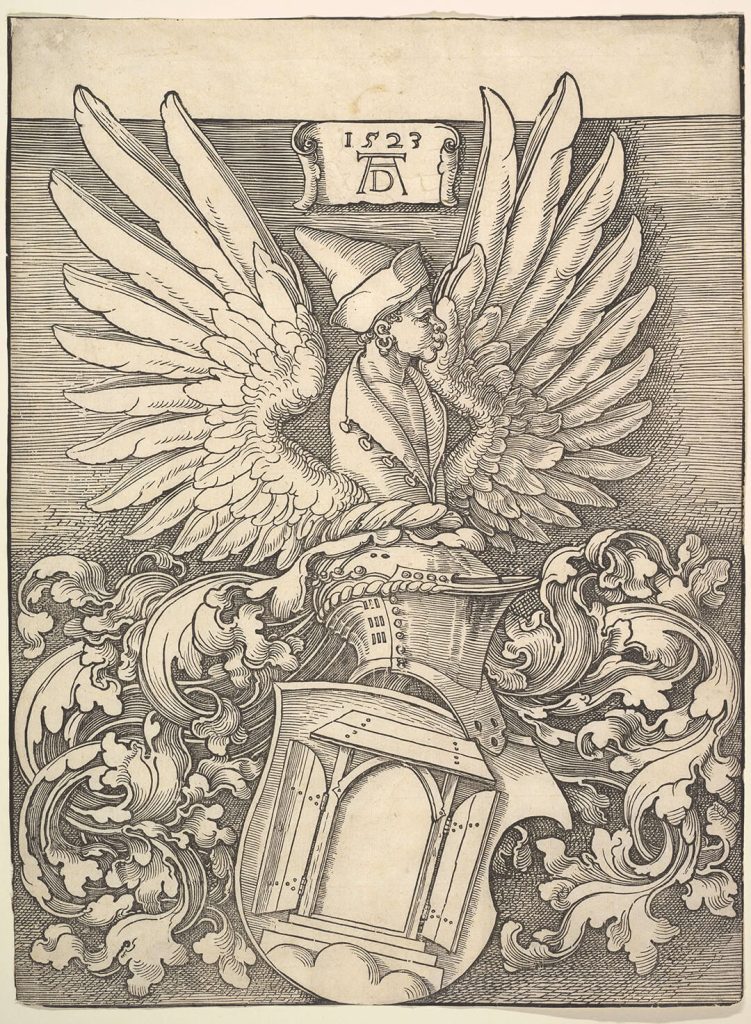
The inclusion of such heads did not necessarily indicate derogatory assumptions. In the case of the Dürer crest, the head may well have been added to signify Dürer’s worldliness and cosmopolitan outlook, though the recasting of an African head as a covetable exotic inevitably springs from an established system of signifiers of European imperialism. Dürer’s earlier charcoal Portrait of an African (1508) and silverpoint drawing, Portrait of Katharina (1521) remain amongst the most touching and humane European depictions of peoples of non-Western origins from the period, owning nothing to visual stereotyping and enlivened by Dürer’s sensitive penmanship. Little is known of the first subject, but Katharina is believed to have been a twenty-year-old servant of João Brandão, the representative of the King of Portugal in Antwerp and Dürer’s host when he visited the city during his trip to the Netherlands in 1520–1521.[21] Dürer’s diaries recount that he “portrayed with metalpoint his [Brandão’s] negress.”[22] It is notable that he composed his own family crest after these earlier artistic endeavors.
Though two hundred plus years would elapse, encompassing myriad advances in the science of human and animal biology, Renaissance treatises such as menschlicher Proportion continued to serve as references in the eighteenth century and beyond.[23] The evocative woodcut images of [361] human-animal affinities from Giambattista della Porta’s De humana physiognomia (1586) hover spectrally above the proto-evolutionary sequences from later physiognomic treatises such as Camper’s Dissertation physique (1791), and were surely known to the court painter Charles Le Brun (1619–1690), whose physiognomic drawings of animal and human heads were posthumously published in 1806.[24] Dürer, for his part, explicitly served as both foil and counterpoint for eighteenth-century theorists of race and biological morphology. Lavater, the author of Essays on Physiognomy (1777), directly refers to Dürer multiple times, while Camper positions himself in dialogue with Dürer, claiming in one instance that Dürer’s heads were generally “too broad,” a determinant Camper had made through “modelling in clay, after the finest heads of antiquity.”[25] Dürer was still in use as a reference in the early twentieth century, for instance in Thompson’s On Growth and Form (1917), a weighty text on the morphogenesis of animals and plants illustrating how diverse species might be deformed into each other by varying their coordinates upon a grid (figure 8).[26] On Growth and Form owed the privileged position of its descriptive diagrams to menschlicher Proportion and its landmark contributions to the geometrical foundation of difference and similarity.
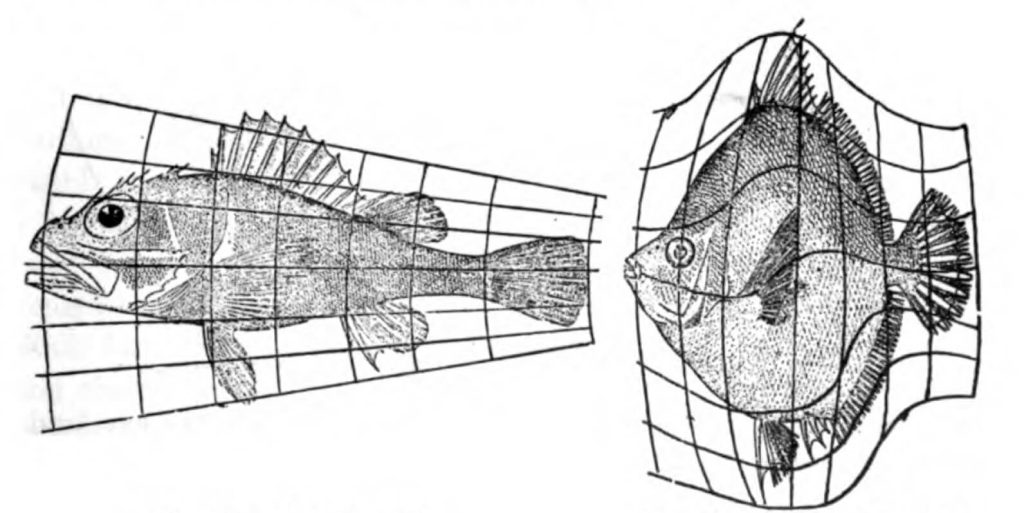
• • •
The overriding perception of menschlicher Proportion is as a set of investigations on human proportion tied together by Dürer’s interpretive Meynung [opinion]. Still, Dürer was not immune to what the philosophers Theodor W. Adorno and Max Horkheimer would later identify as the “dialectic of Enlightenment,” where even a catalogue of difference is prone [362] to collapse and to the defeat of its intrinsic logic.[27] Dürer’s methodological wavering, his calculated indecision and representation of multiple systems of measurement, may have tacitly accommodated for a cascade of misappropriating and racialized views and opinions. Despite his attempt to create a graphic apparatus to account for the natural diversity of the human figure, one of the most significant outcomes of menschlicher Proportion was its rampant use by others to exclude the same variation it had sought to describe.
That the following centuries weaponized these visual strategies to great and devastating effect is already history, albeit a still-present history continuously unveiling itself. From catalogues echoing Lavater’s and Camper’s physiognomic stereotypes in the outlining of the silhouettes of African slaves in the Americas to the pervasive, anti-Semitic propaganda of the Third Reich, the ensuing cultural history of the profile became a media shorthand for unbridgeable difference and the indisputable aesthetic [363] superiority of white Christians.[28] Unlike the many medieval depictions of non-Europeans, which appeared as ornamental embellishments or as manuscript images seeking to encapsulate the subject in his most representative behavior, the Enlightenment-era treatises made use of the potent, de-contextualized visual language so effectively innovated by Dürer. By way of example, the shocking and inexcusable images in Dissertation physique dramatize the development of the skull in profile, mapping its evolution from ape to that of a person of color and unto a spectrum of white Europeans. Superimposed one on top of the other (figure 9) or encapsulated in a series of profiles whose angular facial lines (running [364] from forehead to lip) progress closer to a desired value approximating ninety degrees, Camper strove to define the facial line as the most appropriate method for analyzing anthropological variety, defending his studies on the basis of direct examination of human and animal skulls.[29]
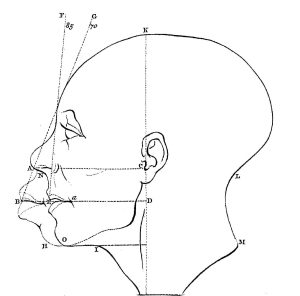
According to Camper, graphically tweaking the facial line to different degrees generated the entire spectrum of human and animal cranial anatomy, with the proportions of classical antiquity constructing a skull defined closer to an imaginary vertical at one end and the far more oblique angle of the ape at the other.[30] Recalling his study of his collection of human skin specimens, Camper concluded that pregnancy has the capacity to cause shifts in the skin’s hue so that the “membrane becomes as black in our fairest women, during their pregnancy, as that of the blackest negro or Angolese.” By his reasoning, the “fairest skin may become black, and the darkest become fair” as a result of natural biological processes, environmental influence, or without discernable cause, and furthermore as perception of color itself depends upon how “rays of light are refracted” upon the surface of the eye. Düreresque diagrams such as his that isolated and revealed the essential mathematics of the facial [365] line provided the most objective approach to a comparative study of the human head.[31]
The import projected upon the human profile reached the apex of its legitimacy in late eighteenth-century science.[32] Prevailing opinion held, per Lavater, that the many and variegated attempts of man “to appear wiser, better, and honester than, in reality” were bound to flounder upon the unforgiving shores of physiognomy. As he asserts, “There are many features, or parts of the body, which are not susceptible to dissimulation … and, indeed, such features are indubitable marks of internal character.”[33] To dispassionately study the face was to turn man inside out and to reduce him to his indelible physiological traces, those hard or firm parts of the body that eluded the power of his will to mold. As he concludes, “What man … would be able to alter the confirmation of his bones … Can any fashion the flat and short into the well-proportioned nose? Who can make his thick lips thin, or his thin lips thick?”[34]
Critically, that which needed to be cast aside and held in furthest opposition to a Western European ideal varied wildly. Camper’s ape, so to speak, has at different moments in time stood in for the Black, but also the woman, the criminal, and the Jew among other oppressed or marginalized groups. This innate flexibility of the profile construct only reinforced the operational impact of the visual strategy and the ease with which diverse, if innately prejudicial, value systems could be effectively superimposed upon the human outline. Reducing man or woman to a two-dimensional reproduction of his or her profile and subjecting this image to measurement, or measuring subjects against this image, proved to be a perniciously successful visual argument. This evaded the potential for sympathy and identification spurred by looking directly into the eyes of the other, much as the mugshot or the lineup continue to harness and [366] exploit the malleable otherness required by the institutional gaze. From counter-terrorism to modern policing, the split-second judgements that enact the power of the law owe their existence to robustly constructed corridors of premodern thought that far predate any modern form of governmentality — and to the Renaissance history of a companion visual culture of diagrams flexible enough to accommodate for potential shifts in interpretive reading, namely, in the priorities and targets of power. Thus, as with menschlicher Proportion, even if the links between the profiles and their original meanings remain up for interpretation now, obscured as they may be behind five hundred years and the “period eye,” the diagrams themselves, supported by the discourse on physiognomy, bolstered with learned knowledge of classical texts, and framed by informational graphics and explanatory markings, strip the primary field of expressive action from the face of the other and transplant it onto the page. Positioned at a perpendicular to the dispassionate gaze of the trained observer and denied its capacity for dissimulation, the face is delegated an ethical position in absentia, a profile without profile, not a double but a terrible sameness leaving no room for alterity.
Curiously, there are instances of Dürer’s private explorations breaking with the graphic convention of the printed human profile (figure 10). Hidden in a sheet of drawn studies from 1513, Dürer arrays a compressed sequence of ten faces bookended by two classic stereotypes that he would describe in his “Aesthetic Excursus,” appended to Book III of menschlicher Proportion, as “two species of mankind, whites and negroes; in these a difference in kind can be observed as between us and them.”[35] It has been noted that it is only the last, Africanized profile who is “rendered conscious of the series to which it belongs.”[36] As variable as the adjacent folds of drapery, there are, for Dürer, “many varieties and causes of beauty … ” as well as “a great harmony in diversity.”[37] And yet it is only the last man, the only man, his one eye swiveling in its socket towards us in this final image, who by virtue of his difference is able to pierce the veil of representation and in so doing become privy, in horror, to what is to come. [367]
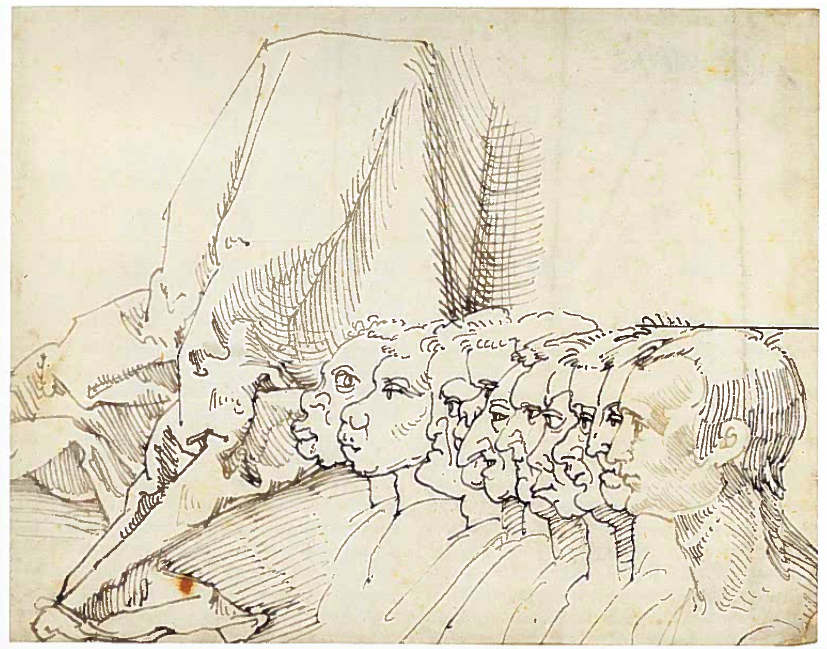
Suggestions for Further Readings
Bindman, David, Ape to Apollo: Aesthetics and the Idea of Race in the 18th Century. Ithaca: Cornell University Press, 2002.
Dennis, David B. Inhumanities: Nazi Interpretations of Western Culture. Cambridge: Cambridge University Press, 2012.
Panofsky, Erwin. The Life and Art of Albrecht Dürer. Princeton: Princeton University Press, 2005 [1943].
Strickland, Debra Higgs. “Monstrosity and Race in the late Middle Ages.” In The Ashgate Research Companion to Monsters and the Monstrous, 405–426. Farnham, UK: Routledge (2017).
- For further reading on classical physiognomy, see Benjamin Isaac, The Invention of Racism in Classical Antiquity (Princeton: Princeton University Press, 2004); Tamsyn Barton, Power and Knowledge: Astrology, Physiognomics, and Medicine under the Roman Empire (Ann Arbor: University of Michigan Press, 2002); Elizabeth C. Evans, “Physiognomics in the Ancient World,” Transactions of the American Philosophical Society 59.5 (1969): 1–101. For a cross-cultural analysis of classical physiognomy, see Su Fang Ng, Alexander the Great from Britain to Southeast Asia: Peripheral Empires in the Global Renaissance (Oxford: Oxford University Press, 2019). ↵
- See the classical Physiognomica, a peripatetic text dating from the third century B.C. that maintained its popularity through the Middle Ages and into the early modern period; Essays on Physiognomy [1777] by Johann Kaspar Lavater; Petrus Camper’s Dissertation physique (1791); and Rassenkunde des deutschen Volkes [Racial Ethnology of the German People] (1922) by Hans F. K. Günther (1891–1968), an academic whose physiognomic writings was celebrated during the Nazi regime, among many other examples. ↵
- See Body and Building: Essays on the Changing Relation of Body and Architecture, edited by George Dodds and Robert Tavernor (Cambridge: MIT Press, 2002). ↵
- Albrecht Dürer, “Drafts for the Introduction to the Book of Human Proportions,” A Documentary History of Art, edited by Elizabeth G. Holt, translated by William Martin Conway (Garden City, NY: Doubleday Anchor, 1957), 311–318, here 316. On “licentious” form and proportion, see Sebastiano Serlio on Architecture, edited by Vaughan Hart and Peter Hicks (New Haven: Yale University Press, 2001), 99v. ↵
- Martin Kemp, Visualizations: The Nature Book of Art and Science (Berkeley: University of California Press, 2000), 15. ↵
- On Leonardo, see Michael W. Kwakkelstein, Leonardo da Vinci as a Physiognomist: Theory and Drawing Practice, (Leiden: Primavera Press, 1994); Piers D. G. Britton, “The Signs of Faces: Leonardo on Physiognomic Science and the ‘Four Universal States of Man,’” Renaissance Studies 16.2 (2002): 143–62; and Martin Clayton, Leonardo da Vinci: The Divine and The Grotesque, (London: Royal Collection Enterprises, 2002). On Rubens, see Tine Meganck, “Rubens on the Human Figure,” Rubens: A Genius at Work (Tielt: Lannoo, 2007) 52–64; and Catherine H. Lusheck, “Figuring Eloquence: The Kneeling Man and Rubens's Construction of the Robust Male Nude,” in Rubens and the Eloquence of Drawing (London: Routledge, 2019) 162–234. ↵
- David B. Dennis, Inhumanities: Nazi Interpretations of Western Culture, (Cambridge: Cambridge University Press, 2012), 404. See also Thomas Schauerte, “Hitler’s Dürer? The Nuremberg Painter between Self-Portrayal and National Appropriation,” The Primacy of the Image in Northern European Art, 1400–1700. (Leiden; Boston: Brill, 2017), 315–28. ↵
- David Bindman, Ape to Apollo: Aesthetics and the Idea of Race in the 18th Century, (Ithaca: Cornell University Press, 2002), 12–13. See also Robert Bernasconi, “Who Invented the Concept of Race?,” Theories of Race and Racism: A Reader, edited by Les Back and John Solomos, 2nd ed. (London; New York: Routledge, 2009), 83–103; and Miriam Eliav-Feldon, Benjamin H. Isaac, and Joseph Ziegler, The Origins of Racism in the West, (Cambridge: Cambridge University Press, 2009). On Goethe and physiognomics, see Richard T. Gray, About Face: German Physiognomic Thought from Lavater to Auschwitz, (Detroit: Wayne State University Press, 2004), 137–76. ↵
- See the work of Joy Buolamwini (1989–) and the Algorithmic Justice League, https://www.ajlunited.org/ (accessed December 11, 2019). ↵
- Isaac, Invention of Racism, 151. ↵
- Debra Higgs Strickland, “Monstrosity and Race in the late Middle Ages,” The Ashgate Research Companion to Monsters and the Monstrous, (Farnham, UK: Routledge, 2017), 405–26. ↵
- Psalm 72/71:0. Quoted from Strickland, “Monstrosity,” 382. ↵
- The full title reads Hierin sind begriffen vier bûcher von menschlicher Proportion durch Albrechten Dürer von Nürnberg erfunden und beschriben/zu nutz allen denen so zu diser kunst lieb tragen. (Nuremberg: Hieronymus Andreae, 1528). See Peter Parshall, “Graphic Knowledge: Albrecht Dürer and the Imagination,” The Art Bulletin 95.3 (2013): 393–410; and Rainer Schoch, Matthias Mende, and Anna Scherbaum, Albrecht Dürer: Das Druckgraphische Werk, 3 vols. (Munich: Prestel Verlag, 2001–2004), 3:319–29. ↵
- Albrecht Dürer, translated in William Martin Conway, Literary Remains of Albrecht Dürer, (Cambridge: Cambridge University Press, 1889), 175. With reference to the Dürer manuscripts at the British Museum, Vol. 4, 132a and b. ↵
- Erwin Panofsky, The Life and Art of Albrecht Dürer, (Princeton: Princeton University Press, 2005), 264; and Robert Tavernor, On Alberti and the Art of Building (New Haven: Yale University Press, 1998), 40–41. For Dürer’s reference to the measurement of human models, see menschlicher Proportion, fol. T3r. ↵
- For exposition on the evolution of Dürer’s proportional theories, see Berthold Hinz, “‘Von menschlicher Proportion’: Ablauf und Gliederung” and “Die ‘Messung’: Fragen und Antworten,” in Albrecht Dürer: Vier Bücher von menschlicher Proportion (1528), edited by Berthold Hinz (Berlin: Akademie Verlag, 2011) 331–37 and 339–53. ↵
- “vnnd wie so manicherley gestalt der angesicht zu machen seyen.” Dürer, menschlicher Proportion, 1528, fol. P5r. ↵
- “Das erst haubt gewindt ein spizige stirn/ aber das ander hinden ein hoch haubt,” Dürer, menschlicher Proportion, fol. P4r and fol. Q2r. ↵
- “Wie dann des die natur villerleu gibt.” Dürer, menschlicher Proportion, fol. Q3r. ↵
- “aber solche ob beschrybne meynung diendt als mer zu vnderchyd dann zu gestalt der hübsche.” Dürer, menschlicher Proportion, fol. Q3v. ↵
- “Albrecht Dürer’s Sketches,” Black Central Europe. https://blackcentraleurope.com/sources/1500-1750/albrecht-durers-sketches-1508-1521/ (Accessed January 2, 2020). On Katharina, see Diane Wolfthal, “Household Help: Early Modern Portraits of Female Servants,” Early Modern Women (2013), 5–52, at 14–22. ↵
- Quoted from Joseph Leo Koerner, “The Epiphany of the Black Magus circa 1500,” The Image of the Black in Western Art: Volume III: Part 1. “From the Age of Discovery” to the Age of Abolition: Artists of the Renaissance and Baroque, edited by David Bindman and Henry Louis Gates Jr., (Cambridge: Harvard University Press, 2010), 7–92, at 56. ↵
- For a list of the editions of Vier Bücher von menschlicher Proportion, see Berthold Hinz, ed., Albrecht Dürer: Vier Bücher von menschlicher Proportion (1528), 1–4. ↵
- On Le Brun, see Jennifer Montagu, The Expression of the Passions: The Origin and Influence of Charles Le Brun‘s “Conference Sur L’expression Générale Et Particuliere,” (New Haven: Yale University Press, 1994); Sarah R. Cohen, “Searching the animal psyche with Charles Le Brun,” Annals of Science 67.3 (2010): 353–82. ↵
- Petrus Camper, The Works of the Late Professor Camper, translatd by T. Cogan, (London: Printed for C. Dilly, in the Poultry, 1794), 6, 38–39. ↵
- D’Arcy Wentworth Thompson, On Growth and Form, edited by John Tyler Bonner, (Cambridge: Cambridge University Press, 2000 [1917]), 290–91. ↵
- See “The Concept of Enlightenment,” Theodor W. Adorno and Max Horkheimer, Dialectic of Enlightenment, translated by E. Jephcott (Stanford, Stanford University Press, 2002 [1947]), 1–34. ↵
- On the visual history of the silhouette and its intersection with the racial politics of American culture, see Asma Naeem, Black Out: Silhouettes Then and Now, (Princeton: Princeton University Press, 2018). ↵
- “When in addition to the skull of a negro, I had procured one of a Calmuck [a branch of the Mongolian race], and had placed that of an ape contiguous to them both, I observed that a line, drawn along the forehead and the upper lip, indicated this difference in national physiognomy; and also pointed out the degree of similarity between a negroe and the ape. By sketching some of these features upon a horizontal plane, I obtained the lines which mark the countenance, with their different angles. When I made these lines to incline forwards, I obtained the antique head; backwards, the head of the negroe; still more backwards, the lines which mark an ape, a dog, a snipe [a wading bird species], &c.” Camper, Works, 9. With slight modifications to the translation by author. ↵
- Notwithstanding the dated problematics of the enterprise, Camper elsewhere stressed the overall unicity of the human race, claiming that the zoological comparison was morphological only and not indicative of any a priori affinities between any one human group and animal species. Moreover, he remained categorically opposed to using skin color, that which is commonly used today as the prevailing visual marker dividing majority from minority, as indicative of human difference. His position against discrimination on the basis of skin color is most fully articulated in Redevoering over den oorsprung en de kleur der zwarten (Oration on the origin and color of the blacks), 1795. ↵
- Camper, Works, 16–17. ↵
- There were, however, dissenting views that stressed the schema’s over-reductiveness. See for example The Anthropological Treatises of Johann Friedrich Blumenbach, edited by Thomas Bendyshe (London, 1865); and Bindman, Ape to Apollo, 209. ↵
- Johann Caspar Lavater, Essays on Physiognomy [1777], translated by Thomas Holcroft, (London: W. Tegg, 1878), 83–84. ↵
- Johann Caspar Lavater, Essays on Physiognomy, 84. See also Gray, About Face, 340. ↵
- Albrecht Dürer, “Aesthetic Excursus,” A Documentary History of Art, 318–29, at 324–25. ↵
- Koerner, “Black Magus,” 84. ↵
- Dürer, “Aesthetic Excursus,” 317. ↵

